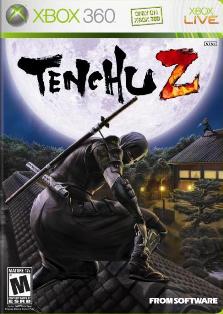Tenchu Z
| Tenchu Z | |
|---|---|
 | |
| Developer(s) | K2 LLC |
| Publisher(s) | |
| Director(s) | Kiyoji Tomita |
| Producer(s) | Masanori Takeuchi |
| Designer(s) | Kiyoji Tomita |
| Programmer(s) | Tadao Maruta Shinichi Shimizu Osamu Matsuki Kazufumi Yoshida Masato Ōbuchi Tomoaki Niki Hiroshi Kondo |
| Series | Tenchu |
| Platform(s) | Xbox 360 |
| Release | |
| Genre(s) | Action-adventure, stealth |
| Mode(s) | Single-player, co-op |
Tenchu Z (天誅 千乱, Tenchu Senran) is an action-adventure stealth video game developed by K2 LLC and published by From Software for the Xbox 360 in 2006.
It is different from previous games in the series in that the player creates their own ninja characters, then builds up their skills as they play through the game rather than choosing from a small selection of pre-made characters, as they take orders from the series' previous main male character, Rikimaru. It also features four-player cooperative play through Xbox Live.
Plot
The country of Gohda, where the Azuma clan of ninja reside under the service of Lord Gohda, is on the brink of war with the neighboring country of Ogawara. As a new recruit in the Azuma clan, the protagonist is sent to assassinate those who are assisting Ogawara, including army officials and spies who have infiltrated Gohda, as well as recover stolen items and rescue prisoners. In between thwarting Ogawara's plans, the protagonist also receives missions in which he/she eliminates evil people such as abusive monks and greedy merchants.
There is no connection between Tenchu Z's plot and those in the previous games, nor are there any returning characters with the exceptions of Rikimaru and Lord Gohda.
Gameplay
Tenchu Z is the largest game in the series to date, containing 50 missions with different difficulty settings and objectives. Characters also have different attributes (which are strength, agility, and health) that can be altered to make a ninja all your own.
The game's character edit features are quite in-depth, allowing the player to use gold obtained by doing well in missions both in single player and multiplayer to purchase new aesthetic styles for your ninja, new abilities, items to use during missions, and different special attacks to use in combat, in addition to combo-editing abilities.
Gameplay is relatively the same as the previous games in the series. The main difference is that, as mentioned above, players create their own character and unlock new skills, items and clothing for him or her as the game progresses. Only one fighting style is available: a ninjato that can either be set with slower but more damaging attacks (the same as Rikimaru's in previous games) or faster and weaker attacks with different animations. The unlockable skills however are more varied, with most of them making their first appearance in the series while others return from previous games with some tweaks. Certain skills can be upgraded twice, enhancing the protagonist's abilities beyond those of the characters from previous games.
Enemies can now hear the protagonist's footsteps if he or she runs too close to them, and they may hear the footsteps from a greater distance if the protagonist runs on noisy surfaces such as a puddle of water. They can also smell the protagonist if he/she falls into a cesspool (only found during some missions; after the protagonist emerges from the cesspool, a brown haze surrounds him/her, indicating that he/she can be detected by smell at a certain distance) or is covered with blood from an earlier fight. Unlike the previous games, lighting is also a factor here as the protagonist is less likely to be spotted while standing or crouching in a dark area.
Reception
| Aggregator | Score |
|---|---|
| Metacritic | 56/100[1] |
| Publication | Score |
|---|---|
| 1Up.com | C+[2] |
| Edge | 6/10[3] |
| Eurogamer | 3/10[4] |
| Game Informer | 6.5/10[5] |
| GamePro | |
| GameRevolution | D[7] |
| GameSpot | 4.9/10[8] |
| GameSpy | |
| GameTrailers | 5.9/10[10] |
| GameZone | 5.5/10[11] |
| IGN | 5.2/10[12] |
| Official Xbox Magazine (US) | 5/10[13] |
| The A.V. Club | C[14] |
This section needs expansion. You can help by adding to it. (August 2013) |
Tenchu Z received "mixed" reviews according to video game review aggregator Metacritic.[1]
References
- ^ a b "Tenchu Z for Xbox 360 Reviews". Metacritic. Retrieved August 11, 2013.
- ^ Mielke, James (June 12, 2007). "Tenchu Z (Xbox 360)". 1UP.com. Retrieved December 20, 2013.
- ^ Edge staff (September 2007). "Tenchu Z". Edge (179): 95.
- ^ Whitehead, Dan (June 26, 2007). "Tenchu Z Review". Eurogamer. Retrieved December 20, 2013.
- ^ Bertz, Matt (August 2007). "Tenchu Z". Game Informer. Archived from the original on January 17, 2008. Retrieved December 20, 2013.
{{cite web}}: Unknown parameter|deadurl=ignored (|url-status=suggested) (help) - ^ Papa Frog (June 19, 2007). "Review: Tenchu Z". GamePro. Archived from the original on June 24, 2007. Retrieved December 20, 2013.
{{cite web}}: Unknown parameter|deadurl=ignored (|url-status=suggested) (help) - ^ Hurh, JP (June 13, 2007). "Tenchu Z Review". Game Revolution. Retrieved December 20, 2013.
- ^ Thomas, Aaron (June 12, 2007). "Tenchu Z Review". GameSpot. Retrieved December 20, 2013.
- ^ Graziani, Gabe (June 28, 2007). "GameSpy: Tenchu Z". GameSpy. Retrieved December 20, 2013.
- ^ "Tenchu Z, Review". GameTrailers. June 18, 2007. Retrieved December 20, 2013.
- ^ Hopper, Steven (June 18, 2007). "Tenchu Z - 360 - Review". GameZone. Archived from the original on October 9, 2008. Retrieved December 20, 2013.
{{cite web}}: Unknown parameter|deadurl=ignored (|url-status=suggested) (help) - ^ Irwin, Mary Jane (June 19, 2007). "Tenchu Z Review". IGN. Retrieved December 20, 2013.
- ^ "Review: Tenchu Z (X360)". Official Xbox Magazine: 82. August 2007.
- ^ Mastrapa, Gus (July 2, 2007). "Tenchu Z". The A.V. Club. Archived from the original on July 5, 2007. Retrieved December 20, 2013.
{{cite web}}: Unknown parameter|deadurl=ignored (|url-status=suggested) (help)
